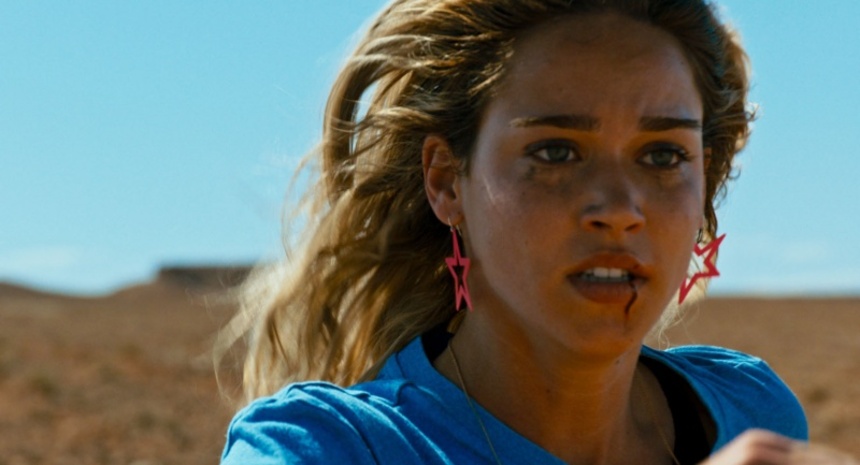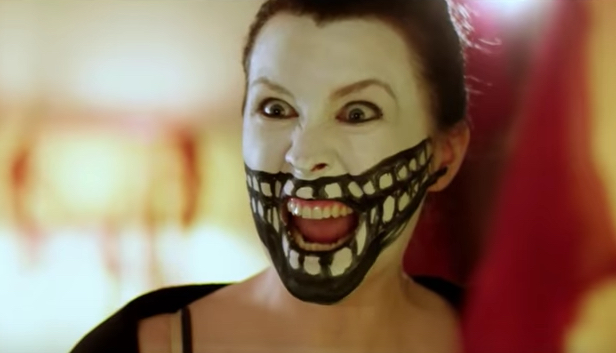Book Review: BEYOND EMPOWERTAINMENT, Following the Footsteps of Feminist Horror

Women characters have always been at the heart of horror films, though arguably not always for the best reason (as Argento said, people love to see beautiful women getting killed). But there's been a shift in recent years; rather than always showing women in peril, or even just the heroic Final Girl, many horror films have shifted from external to internal struggles. More women filmmakers, and smarter male ones, are creating women characters that find and extert their own power from within (for better or sometimes worse).
Seventh Row have recently published a new e-book that looks at a crop of recent (mostly) horror films that feature women characters finding and exerting this internal power. Beyond Empowertainment: Feminist horror and the struggle for female agency edited by Alex Heeney, Mary Angela Rowe, and Orla Smith, covers ideas such as revenge, madness, growing up, and technology, and the female characters at the front of these films who must examine their relationship to each, and the various themes therein. It's a timely book not only for those who study horror, but those who want to read more in-depth about complex female characters (still too lacking in film).
In her foreward, Mary Angela Rowe sets up the kind of films that will be examined in the book, and why. Specifically, looking at films the editors consider as feminist horror texts, with female characters at the centre, whose enemy is not wielding a knife or chasing them in dreams, but rather their own selfs, or as often, the patriarchal society in which they exist. And the decision to focus almost entirely on films made in the past few years (the exception being Perfect Blue) certainly allows more of a focus on women filmmakers and the new expressions and ideas they bring to horror films.

Part One covers revenge horror; given the importance of revenge in horror films, it's a bit odd that it's the shortest section of the book, and only has one actual essay. The interviews, first about Revenge (2017) with director/writer Coralie Fargeat and actor Matilda Lutz, the second Prevenge with director/writer/actor Alice Lowe. Both interviews are interesting to read, coovering the process of making the films, the hurdles Fargeat and Lowe both had to overcome in terms fo the material, letting their voice come through (and the more practical with directing while pregnant for Lowe). These are both great ways to get to know a bit more in-depth about the people and ideas behind the films. The essay on representations of violence against women by Manuela Lazic, feels out of place given the context of the book. Neither of the texts under discussion, Elle and Big Little Lies, are horror films. Elle does occasionally use some horror elements, but Big Little Lies does not fit at all within the canon, and is not a revenge scenario. While this is not to say the essay isn't well-written, it feels as though there is force being used to make it work for the book, rather than write about films that fit more with the theme of the book.
Madness is the theme of Part 2, certainly one with ample example in horror cinema. It begins with an essay by Smith on the 'female monster', looking in depth at three films made by white male directors with white female protagonists, who are driven to madness and kill their abusers; but, to Smith, the characters feel devoid of internal life. Her argument is that this is in part due to their male creators, who do not seek to understand the effect that misogyny and the patriarchal cultures in which each character lives affects their behaviour. But the three films in question - Lady Macbeth, Ex Machina, and Beast, again, are not exactly horror films - the last one arguably, but not the others, and an argument could be made that it isn't madness that drives the female characters to their violence, as Smith concludes. But it's certainly an engaging perspective, even as there is much to debate about. Smith then compares these films to Raw and Thelma, far more representative of the female experience of madness induced by patriarchy and misogyny.
Next in the section, Naomi Gessesse writes a terrific in-depth analysis of Perfect Blue, a rare example of feature-length animated horror, and the only non-western film studies in depth. Gessessee gives very detailed attention to the mise-en-scene of the film and the use of the anime style, to tell the story of this girl fighting for her own identity against men who would keep her under control. There's an interview with Saint Maud director Rose Glass, about the film about how to make a mad woman more than a one-dimensional character. The case study of this section of Stephen Soderberg's low-budget horror-thriller Unsane. Scott Wilson looks at how patriarchal power structures create inequality, which is great to analyse in the film, while Smith looks at the horrifying and persistant trope of the Manic Pixie Dream Girl, and how this works against the main character. Interviews with the production and costume designers are a rare treat, giving insight into not only how Soderberg works, but how designers contribute to a film's detail. And finally, Heeney looks at Unsane's lead actor Claire Foy - perhaps spending a bit too much time on her earlier work, but looking closely at how she has evolved to play someone driven insane, yet taking back control.
Part three looks at technology horror; while not new as a subgenre, it takes on greater relevance in an age when we have instant messaging, and video conferencing, not to mention manipulation of photos and videos. Rowe's introduction to the section gives a good overview of it perspective and the film selection, based on the real usage and consequences of current technologies. Elena Lazic's piece on Cam is a great look not only in that it is sex work-positive, but how the films examines sex worker's negotiation of technology, given that cam girls rely on it for their living, in order to maintain control and safety (and how the world still discriminates).

Personal Shopper is the case study of this section, a film that takes a different walk through horror (arguably something more in the supernatural/fantastic arena), that nonetheless uses technology as an object to be feared. Joseph Earp takes an interesting look at the persona of lead actor Kristen Stewart, how the (false) image of her as a bad or bland actor, is reinterpreted in her performace of someone who is haunted. Mike Thorns looks at the horror generated by the text messages, both literally in that we do not know who is sending them (a real person pretending to be main character Maureen's dead brother, or the dead man himself), and the horrors created by Maureen as she follows the texts' instructions, making her own life into a horror film. Heeney turns her attention to how we view those who spend a lot of time on smartphones; does technology have a negative affect on our emotional stability, or is it our sadness that compels us to spend more time with these objects?
The fourth and final section covers 'coming of age' horror - and certainly, filmmakers have long uses female puberty as a site of horror. It begins with an interesting essay by Jake Pitre, about a lesser-known horror film from Québec, The Little Girl Who Was Too Fond of Matches. While it talks more about how the film fits into (or perhaps does not) this history of the region's horror cinema, than about the topic at hand, it serves as an introduction to how the patriarchy (and in the case of Québec films, religious control) treats female puberty as something monstrous. This serves as a good opening to the first case study of the chapter, Thelma. Heeney's introduction serves as a good overview of the film, and a comparison with director Joachim Trier's previous films, which have generally fallen into the social realism category. Smith's comparitive essay on Thelma and Carrie is a great read, looking at how DePalma was more interested in the world around Carrie, whereas Trier focuses on Thelma as a person, and the difference that makes for a female protagonist. Interviews with Trier, his co-writer Eskil Vogt, and his cinematographer Jacob Ihre provide detailed insight into why they decided to make a genre film, and how they adjusted their techniques to tell the story in the best way.
The final section is a case study of Raw, and the first essay wastes no time in going straight for the jugular of this cannibal film. Rowe looks at the symbolism of the act of eating human flesh, what it means for a young, formerly isolated teenager, and the wider metaphor of body changes that force women into situations not of their own making or desire. Smith rescues the sibling bond and details how the older sister is not the villain she might be painted as, merely another young woman who feels lost and alone, and needs someone with whom she can share her plight. And Rosie McCaffrey does a fascinating comparitive study of Raw and Jim Mickle's We Are What We Are, focusing on cannibalism as self-expression, and the differences in how cannibals are portayed across class distinctions and cultures.
Beyond Empowerment provides some very insightful essays on contemporary films, and how they reflect the recent movement of feminist horror. It serves as a great introduction not only to many of the films mentioned, but good points of debate about what makes a horror film feminist, and what patterns and directions the genre is taking.
The e-book Beyond empowerment: Feminist horror and the struggle for female agency is now available for purchase at Seventh Row.







